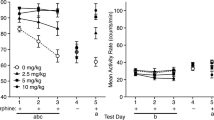Summary
A place preference conditioning procedure was used to characterize the motivational effects of β-endorphin-(1-27), a naturally occurring fragment of β-endorphin (β-EP). The intracerebroventricular (ICV) administration of β-EP, selective μ-(DAGO) or δ-(DPDPE) opioid receptor agonists to rats produced marked preferences for the drug-associated place, whereas the selective κ-opioid receptor agonist, U-50488H produced conditioned aversions. ICV injections of the β-EP-(1-27) (5–20 μg), however, resulted in no preference for either the drug- or vehicle-associated place. Pretreatment with β-EP-(1-27) (10 μg) eliminated the place preference produced by β-EP. It abolished the place preferences induced by both DAGO and DPDPE but did not modify the effects of either U-50488H or the psychostimulant d-amphetamine. These data demonstrate that β-EP-(1-27) selectively antagonizes the motivational effects of μ- and β-opioid agonists and suggest that this fragment may function as an endogenous antagonist of the reinforcing effects of opioid agonists in vivo.
Similar content being viewed by others
References
Akil H, Young E, Watson SJ (1981) Opiate binding properties of naturally occurring N- and C-terminus modified beta-endorphins. Peptides 2:289–292
Amalric M, Cline EJ, Martinez JL Jr, Bloom FE, Koob GF (1987) Rewarding properties of β-endorphin as measured by conditioned place preference. Psychopharmacology 91:14–19
Cotton R, Kosterlitz HW, Paterson SJ, Rance MJ, Traynor MJ (1985) The use of [3H] [d-Pen5, d-Pen5] enkephalin as a highly selective ligand for the δ-binding site. Br J Pharmacol 84:927–932
Dum J, Herz A (1987) Opioids and motivation. Interdisciplinary Sci Rev 12:180–190.
Garzón J, Schulz R, Herz A (1985) Evidence for the ε-type of opioid receptor in the rat vas deferens. Mol Pharmacol 28:1–9
Goodman RR, Houghten RA, Pasternak GW (1983) Autoradiography of [3H]-β-endorphin binding in brain. Brain Res 288:334–337
Hammonds RG, Nicolas P Jr, Li C-H (1984) β-Endorphin-(1–27) is an antagonist of β-endorphin analgesia. Proc Natl Acad Sci USA 81:1389–1390
Handa BK, Lane AC, Lord JAH, Morgan BA, Rance MJ, Smith CFC (1981) Analogues of beta-LPH61 − 64 possessing selective agonist activity at mu-opiate receptors. Eur J Pharmacol 70:531–540
Houghten RA, Johnson N, Pasternak GW (1984) [3H]-β-Endorphin binding in rat brain. J Neurosci 10:2460–2465
Johnson N, Houghten R, Pasternak GW (1982) Binding of [3H]-β-endorphin in rat brain. Life Sci 31:1381–1384
Mucha RF, Herz A (1985) Motivational properties of kappa and mu-opioid receptor agonists studied with place and taste preference conditioning procedures. Psychopharmacology 82:241–245
Mucha RF, Millan MJ, Herz A (1985) Aversive properties of naloxone in non-dependent rats may involve blockade of central β-endorphin. Psychopharmacology 86:281–285
Nicolas P, Hammonds RG Jr, Li C-H (1984) β-Endorphin-induced analgesia is inhibited by synthetic analogues of β-endorphin. Proc Natl Acad Sci USA 81:3074–3077
Nicolas P, Li C-H (1985) β-Endorphin-(1–27) is a naturally occurring antagonist to etorphine-induced analgesia. Proc Natl Acad Sci USA 82:3178–3181
Overton DA (1974) Experimental methods for the study of state-dependent learning. Fed Proc (Biol) 33:1800–1813
Paxinos G, Watson C (1982) The rat brain in stereotaxic coordinates. Academic Press, Sydney
Schulz R, Wüster M, Herz A (1981) Pharmacological characterization of the ε-opiate receptor. J Pharmacol Exp Ther 216:604–606
Shippenberg TS, Herz A (1986) Differential effects of μ- and κ-opioid agonists on motivational processes. NIDA Res. Monogr 75:563–566
Shippenberg TS, Bals-Kubik R, Herz A (1987) Motivational properties of opioids: evidence that an activation of δ-receptors mediate reinforcement processes. Brain Res 436:234–239
Smyth DG (1983) β-Endorphin and related peptides in pituitary, brain, pancreas and antrum. Br Med Bull 39:25–30
Stolerman IP (1985) Motivational effects of opioids: evidence on the role of endorphins in mediating reward or aversion. Pharmacol Biochem Behav 23:877–881
Suh HH, Tseng L-F, Li C-H (1987) Beta-Endorphin-(1–27) antagonizes beta-endorphin-induced hypothermia in mice. Peptides 8:123–126
Tseng L-F, Li C-H (1986) β-Endorphin-(1–27) inhibits the spinal beta-endorphin-induced release of Met-enkephalin. Int J Peptide Protein Res 27:394–397
Van fee JM, Smyth DG, Colpaert FC (1979) Dependence creating properties of lipotropin C-Fragment (β-Endorphin): evidence for its internal control of behaviour. Life Sci 24:495–502
Von Voigtlander PF, Lahti RA, Ludens JH (1983) U50–488: A selective and structurally novel non-mu (kappa) opioid agonist. J Pharmacol Exp Ther 24:7–12
Zakarian S, Smyth DG (1979) Distribution of active and inactive forms of endorphins in rat pituitary and brain. Proc Natl Acad Sci USA 76:5972–5976
Author information
Authors and Affiliations
Additional information
Send offprint requests to R. Bals-Kubik at the above address
Rights and permissions
About this article
Cite this article
Bals-Kubik, R., Herz, A. & Shippenberg, T.S. β-Endorphin-(1-27) is a naturally occurring antagonist of the reinforcing effects of opioids. Naunyn-Schmiedeberg's Arch Pharmacol 338, 392–396 (1988). https://doi.org/10.1007/BF00172115
Received:
Accepted:
Issue Date:
DOI: https://doi.org/10.1007/BF00172115




